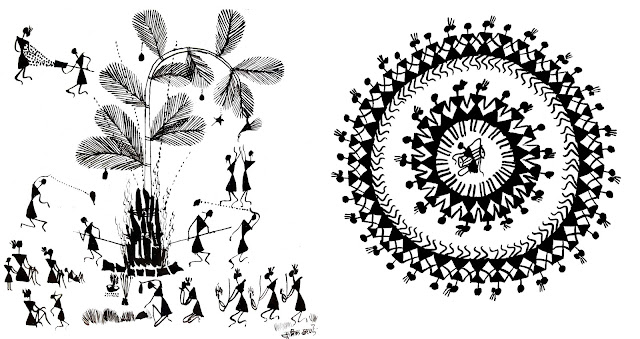It is believed by historians the Warli tradition of art is as old as 3,000 BC. The Warli tribe is from north-west of Mumbai. Traditionally, these paintings do not use straight lines and instead the lines are made by using dots and dashes. They use triangles, squares and circles though. The limbs of the figures are always flowing, graceful and curved. The curved lines of the limbs are an important feature of warli art.
These are just sketches of warli paintings. I have drawn them from the original warli paintings that I have in my possession. These drawings and designs have been traced/copied from the originals. The link to the original paintings is at the end of this post.
The first image is of two different sketches, made from original paintings. The sketch on the left is a depiction of village life. There is a fire in the centre and women stoking the fire. Some people are relaxing while others are working. The sketch on the right in a representation of the typical warli dance with a person in the centre playing a musical instrument.
The image below is drawn from coasters. The warli people's depiction of greenery in their midst.
The sketch below is from a wooden tray. It depicts village life, and some houses as well. Near the house there are two women looking after a baby and in the top left and top right of the photo there are peacocks. Some people are dancing, others playing music, and others with baskets on their heads. Two beautiful palm trees are drawn near the house.
The four images below are taken from wooden coasters and show village women engaged in different activities like weaving, and carrying baskets.
The two images below are from coasters/pen stand, and depict two women with a baby and in the last picture two individuals warming themselves before a fire.
Warli art is unique as the artists work with triangles and curves, not straight lines. If at times you find a straight line in any of the drawings above (for example in the thatched hut) that has been done by me as I was unable to perfectly draw the curved lines.
Related Images: Warli Paintings Photographs
-->
These are just sketches of warli paintings. I have drawn them from the original warli paintings that I have in my possession. These drawings and designs have been traced/copied from the originals. The link to the original paintings is at the end of this post.
The first image is of two different sketches, made from original paintings. The sketch on the left is a depiction of village life. There is a fire in the centre and women stoking the fire. Some people are relaxing while others are working. The sketch on the right in a representation of the typical warli dance with a person in the centre playing a musical instrument.
The image below is drawn from coasters. The warli people's depiction of greenery in their midst.
The sketch below is from a wooden tray. It depicts village life, and some houses as well. Near the house there are two women looking after a baby and in the top left and top right of the photo there are peacocks. Some people are dancing, others playing music, and others with baskets on their heads. Two beautiful palm trees are drawn near the house.
The four images below are taken from wooden coasters and show village women engaged in different activities like weaving, and carrying baskets.
The two images below are from coasters/pen stand, and depict two women with a baby and in the last picture two individuals warming themselves before a fire.
Warli art is unique as the artists work with triangles and curves, not straight lines. If at times you find a straight line in any of the drawings above (for example in the thatched hut) that has been done by me as I was unable to perfectly draw the curved lines.
Related Images: Warli Paintings Photographs





Hi! Is it possible to use these photos for a brochure I'm making for a non-profit organization I'm working in? You can visit us at http://www.graam.org.in. Thanks for your time.
ReplyDeleteYes sure, as long as you give me credit for the pictures. The credit line should go "Nita Jatar Kulkarni." There is no charge for a non-profit orgnanisation if credit is given.
ReplyDeleteHi Nita, is it possible that you could give me your email id? Perhaps I could email you a copy of the work I am doing so you can be satisfied with the way your art has been portrayed and how credit has been given? Thanks for your time and letting us display your beautiful artwork! =)
ReplyDeleteHullo ab. My email id is blog(dot)nita(at)gmail.com
ReplyDeleteIt will be really nice to see how you have used the work. All the best.
Hi Nita, I have draw ur tray pic on a paper and put at my office desk. Village scene is so live..Thanks for ur pics..Great Art :) Kumudini
ReplyDeleteThats nice to hear Kumudini. :)
ReplyDeletehi, your pictures are really amazing!!!! am from Mauritius,.... the indian folks here, realy like these types of painting,, n i"m making enought profit.
ReplyDeleteIf you are making profit, it is very unethical of you to do so without buying these images from me.
ReplyDeleteDear Madam
ReplyDeleteI would like to use the above art work for the brochure, which will be used for creating awareness among village committees on biodiversity and it’ll not be used for commercial purpose. I need your kind approval on the above matter, if you are willing to make the generous contribution, please send the high resolution image to the following email ecpbr@nbaindia.org
note: photo credit will be given
Thanks for your comment Jahir. I have replied to you on the email id provided.
ReplyDeleteyour warali paintings are very beautiful and creative
ReplyDelete